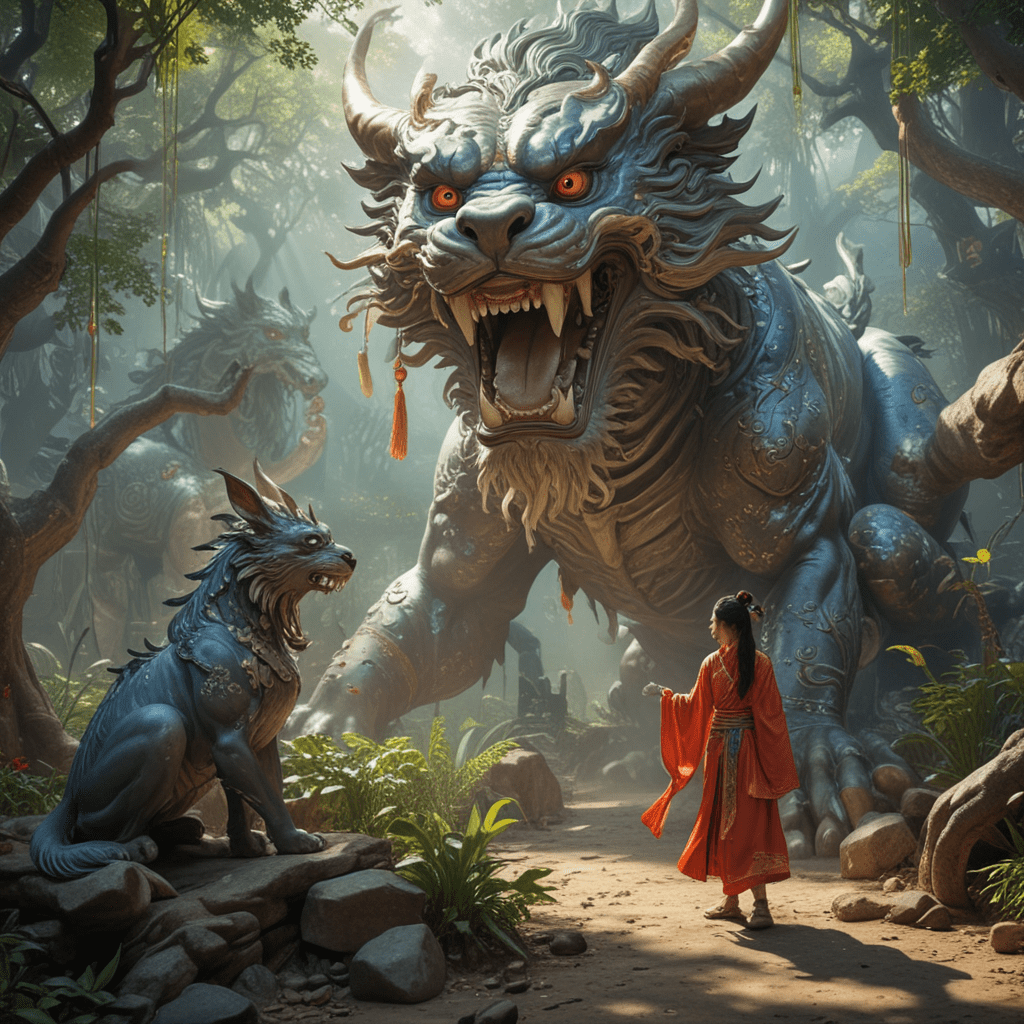1. The Monkey King’s Journey to the West
Embarking on a perilous quest to retrieve sacred Buddhist scriptures from the west, the Monkey King, Sun Wukong, demonstrates his wit and mischievous nature from the outset. With his exceptional agility, magical powers, and a penchant for outsmarting adversaries, the Monkey King's journey is a testament to his ability to navigate both physical and supernatural challenges with equal prowess. His whimsical antics and disregard for authority provide a captivating narrative, solidifying his place as a beloved figure of Chinese mythology.
2. The Eight Immortals and the Peach Tree
An allegorical tale of excess and consequences, "The Eight Immortals and the Peach Tree" revolves around a band of immortals who succumb to temptation. Invited to a grand feast hosted by the Queen Mother of the West, the immortals indulge in the forbidden peaches of immortality, resulting in their expulsion from heaven. This cautionary story highlights the dangers of greed and the importance of self-control, underscoring the moral foundations of Chinese mythology.
3. The Story of Niu Ma Wang
A tale of trickery and disguise, "The Story of Niu Ma Wang" features a fearsome demon king who attempts to disrupt the celestial peach banquet. Disguised as a virtuous monk, Niu Ma Wang infiltrates the heavenly gathering, seeking to steal the precious peaches. However, his deception is exposed by the Monkey King, leading to a chaotic battle and Niu Ma Wang's eventual defeat. This narrative illustrates the themes of deception, cunning, and the triumph of good over evil.
4. The Cunning Carpenter and the Magic Fan
In this tale of ingenuity and resourcefulness, a skilled carpenter outwits a powerful demon. Faced with the task of building a majestic palace, the carpenter is aided by a magic fan that grants him supernatural abilities. However, the demon who possesses the fan attempts to claim the credit for the carpenter's work. Through a clever ruse, the carpenter exposes the demon's true nature, proving that wit and determination can prevail against supernatural forces.
5. The Fox Fairy’s Trick on the Scholar
A cautionary tale against trusting strangers, "The Fox Fairy's Trick on the Scholar" tells the story of a naive scholar who falls prey to the allure of a beautiful fox fairy. Tricked into believing her lies and promises of love, the scholar is ultimately abandoned and left heartbroken. This narrative emphasizes the dangers of deception and the importance of being wary of those who approach with charming appearances.
6. The Magic Paintbrush and the Mischievous Child
In a tale where imagination and creativity take center stage, "The Magic Paintbrush and the Mischievous Child" narrates the story of a young boy who comes into possession of an extraordinary paintbrush. With each stroke, the brush brings his drawings to life, from majestic landscapes to mischievous creatures. However, as the child's curiosity transforms into a mischievous spree, he creates chaos, flooding villages and animating inanimate objects. This narrative explores the themes of responsibility, creativity, and the consequences of unchecked desires.
7. The Legend of the Three Crows
A celestial tale steeped in mythology, "The Legend of the Three Crows" tells the story of ten suns who emerge in the sky, threatening to scorch the earth. Desperate for respite from the scorching heat, the archer Houyi ascends to the heavens and shoots down nine of the suns, leaving only three to illuminate the world. This narrative highlights the Chinese belief in balance and harmony, as well as the importance of respecting the celestial order.
8. The Hare and the Tortoise Race
A classic fable known for its timeless wisdom, "The Hare and the Tortoise Race" teaches the value of perseverance and determination. In this tale, a swift but arrogant hare boasts of his speed, challenging the slow and steady tortoise to a race. Despite the hare's initial advantage, his complacency allows the persistent tortoise to emerge victorious. This narrative emphasizes the importance of humility, diligence, and never underestimating the power of steady effort.
9. The Heavenly Peach Feast and the Jade Emperor's Rage
A celestial banquet filled with intrigue and humor, "The Heavenly Peach Feast and the Jade Emperor's Rage" recounts the story of the Queen Mother of the West's grand peach banquet. When the mischievous Monkey King crashes the feast, chaos ensues, leading to the enraged Jade Emperor's pursuit of the trickster. This tale explores themes of rule-breaking, divine authority, and the consequences of defying celestial powers.
10. The Origin of the Dragon Boat Festival and the Trickster God Zuo Bo
A tale intertwined with history and tradition, "The Origin of the Dragon Boat Festival and the Trickster God Zuo Bo" recounts the legend behind the annual Dragon Boat Festival. When a patriotic poet, Qu Yuan, is unjustly banished, he drowns in the Miluo River. As a tribute to his memory, people race dragon boats and throw rice dumplings into the water to ward off evil spirits. This narrative highlights the importance of honoring tradition, remembering historical figures, and the enduring power of cultural festivals.
FAQ
Q: What is the common theme that runs through these Chinese mythological tales of trickery and mischief?
A: The common thread that weaves through these tales is the exploration of human nature, particularly our capacity for cunning, wit, and the consequences of our actions.
Q: Why are these tales still relevant to readers today?
A: These tales continue to resonate with readers because they offer timeless lessons about morality, the importance of self-control, the power of determination, and the consequences of trickery and deception.
Q: How can parents use these tales to teach their children valuable lessons?
A: Parents can use these tales as a starting point for discussions on ethical decision-making, the importance of honesty, the value of hard work, and the dangers of arrogance and complacency.
